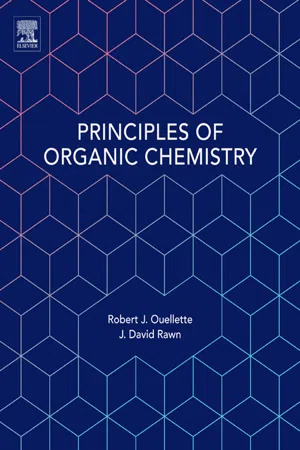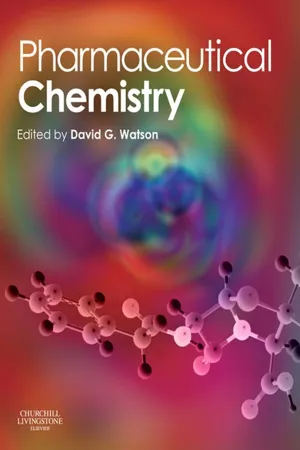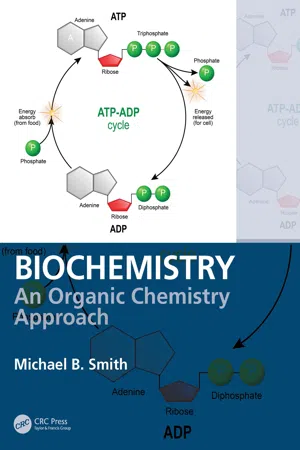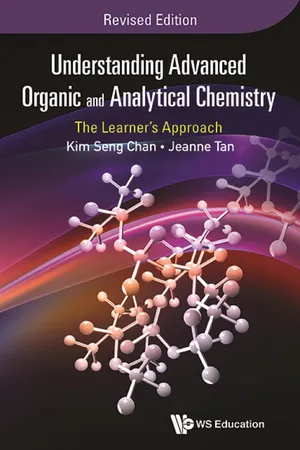Chemistry
Hydroxyl Group
A hydroxyl group is a chemical functional group consisting of an oxygen atom bonded to a hydrogen atom. It is commonly found in alcohols and organic compounds, and its presence can significantly influence the chemical properties of a molecule. The hydroxyl group is characterized by its polar nature, which makes it capable of forming hydrogen bonds with other molecules.
Written by Perlego with AI-assistance
Related key terms
Related key terms
1 of 4
Related key terms
1 of 3
4 Key excerpts on "Hydroxyl Group"
- eBook - ePub
- Robert J. Ouellette, J. David Rawn(Authors)
- 2015(Publication Date)
- Elsevier(Publisher)
8Alcohols and Phenols
8.1 The Hydroxyl Group
Families of organic compounds that have functional groups containing oxygen include alcohols, phenols, ethers, aldehydes, ketones, acids, esters, and amides. Alcohols and phenols both contain a Hydroxyl Group (–OH). A Hydroxyl Group is also present in carboxylic acids, but it is bonded to a carbonyl carbon atom. As a result, the chemistry of carboxylic acids, the subject of Chapter 12 , is substantially different from the chemistry of alcohols and phenols. Alcohols and phenols can be viewed as organic “relatives” of water in which one hydrogen atom is replaced by an alkyl group or an aryl group. Alcohols contain a Hydroxyl Group bonded to an sp3 -hybridized carbon atom. Phenols have a Hydroxyl Group bonded to an sp2 -hybridized carbon atom of an aromatic ring.Common Names of Alcohols
The common names of alcohols consist of the name of the alkyl group (Section 3.3 ) followed by the term alcohol . For example, CH3 CH2 OH is ethyl alcohol and CH3 CH(OH)CH3 is isopropyl alcohol. Other common names are allyl alcohol and benzyl alcohol, whose structures are shown below.The IUPAC system of naming alcohols is based on the longest chain of carbon atoms that includes the Hydroxyl Group as the parent chain. The parent name is obtained by substituting the suffix -ol for the final -e of the corresponding alkane. The IUPAC rules are as follows:1.The position of the Hydroxyl Group is indicated by the number of the carbon atom to which it is attached. The chain is numbered so that the carbon atom bearing the Hydroxyl Group has the lower number.The longest chain that contains the Hydroxyl Group has 4 carbon atoms. An OH group is at C-2 and a methyl group is at C-3. So, the name is 3-methyl-2-butanol2.When the Hydroxyl Group is attached to a ring, the ring is numbered starting with the carbon atom bearing the Hydroxyl Group. Numbering continues in the direction that gives the lowest numbers to carbon atoms with substituents such as alkyl groups. The number 1 is not used in the name to indicate the position of the Hydroxyl Group. - eBook - ePub
- David G. Watson(Author)
- 2011(Publication Date)
- Churchill Livingstone(Publisher)
Chapter 5 Oxygen- and sulphur-containing functional groupsDavid G. WatsonChapter contentsIntroduction 77Monohydric alcohols 78Ethanol 78Other aliphatic alcohols 79Benzyl alcohol 79Diols and triols 79Polyols 80Some chemical properties of alcohols 81Loss of water 81Oxidation 81Phenols 81Esterification 86Ethers 88Aldehydes and ketones 89Carboxylic acids 91Salts of carboxylic acids 93Salts formed between amines and carboxylic acids 94Esters 94Chemical stability 95Enzymatic hydrolysis of esters 97The role of esters in modifying physicochemical properties of drugs 101Esters for improving drug absorption 101Esters for improving water solubility 102Esters used for sustained drug delivery 103Esters for improving drug acceptability and reducing side effects 103The role of esters in terminating drug action 105Participation of the ester group in drug action 105The ester linkage in polymeric drugs 107Esters in biological systems 108Phosphate esters in biology 108Introduction
Oxygen in the most electronegative element found in biomolecules since fluorine does not occur naturally in biological compounds. Its high affinity for electrons means that unlike nitrogen it does not share its lone pairs with protons readily. Thus oxygen-containing groups tend to be less potent in conferring pharmacological activity. For example, dopamine differs from noradrenaline by lacking a Hydroxyl Group but they both have potent effects on the heart: remove the amine group and activity is totally abolished. This is really a generalisation, it is probably truer to say that where oxygen-containing groups play an important role in conferring pharmacological activity they have a very specifically targeted function. In contrast, the charged nitrogen atom exerts a more general effect and may affect a number of targets. This theme will be expanded later in the chapter. Water is the fundamental oxygen-containing biologically active substance and some of its unique properties have been discussed in Chapter 1 - eBook - ePub
Biochemistry
An Organic Chemistry Approach
- Michael B. Smith(Author)
- 2020(Publication Date)
- CRC Press(Publisher)
Any atom other than carbon or hydrogen (e.g., oxygen, nitrogen, sulfur, chlorine, etc.) is called a heteroatom. These heteroatoms are more electronegative than carbon or hydrogen, and the heteroatom will impart bond polarization to any single or multiple bond (C—X or C=X) in the molecule. Such molecules are considered to be polar. The valence of the heteroatom will determine how many atoms are attached to that heteroatom. Oxygen has a valence of 2 and must form X—O—X or C=X species. One possibility is that a C—O—H unit will be formed, where the OH unit is called a Hydroxyl Group. When OH is incorporated into a hydrocarbon molecule in place of one of the hydrogen atoms, the new molecule is called an alcohol. Oxygen also forms a C—O—C unit and molecules containing this unit are called ethers. Nitrogen has a valence of 3 and can form three types of species containing at least one C—N bond: R—NH 2, R 2 NH and R 3 N, where “R” represents a carbon group. These nitrogen-containing units are known as amino groups, and a molecule containing an amino group is called an amine. The OH unit, the C—O—C unit, and the amine units are functional groups. These particular functional groups contain polarized covalent bonds (C=X) and their chemical reactions will differ from the C=C and C≡C units discussed above (see Section 1.10.B). The OH unit attached to carbon in methanol is a functional group called a Hydroxyl Group. A carbon molecule containing an OH group (hydroxyl functional group) is called an alcohol. A primary alcohol is characterized by a RCH 2 —OH unit, a secondary alcohol has the OH unit attached to a carbon atom that has one H and two carbon groups (R 2 CH—OH), and a tertiary alcohol has the OH unit attached to a carbon atom that has three carbon groups (R 3 C—OH). In the IUPAC system, alcohols are named using the carbon prefix and the suffix, -ol (taken from the generic name alcoh ol) - eBook - ePub
Understanding Advanced Organic and Analytical Chemistry
The Learner's ApproachRevised Edition
- Kim Seng Chan, Jeanne Tan;;;(Authors)
- 2016(Publication Date)
- WS EDUCATION(Publisher)
CHAPTER 8
Alcohols and Phenol
8.1 Introduction
Water, H—O—H, is a molecule that is capable of forming hydrogen bonds, and the hydrogen atom is only acidic enough to react with reactive metals, such as sodium, to liberate hydrogen gas. This acid– metal reaction is a characteristic property of an acid, provided the acid is indeed acidic enough to react with the metal. What does it mean? Water is not acidic enough to react with zinc, but hydrochloric acid is. Thus, if one uses zinc metal to determine whether water is an acid or not, then water would fail the acidic test. Other characteristic properties, if they can be observed, include reaction with a carbonate/hydrogencarbonate to give off carbon dioxide gas and reaction with a base to give salt and water. Again, note that an acid may not demonstrate all three characteristics at the same time.If one of the hydrogen atoms of the H−O−H molecule is replaced by a sp3 hybridized carbon atom, one would get a homologous group of organic molecules known as alcohol. These compounds have physical and chemical properties similar to that of water. Alcohols, usually abbreviated as ROH, are organic compounds that contain the hydroxyl functional group, which is basically an −OH group bonded to a C atom. They have the general formula Cn H2n+1OH. The following structure shows the dipoles that are being created in an ethanol molecule due to the more electronegative oxygen atom.Q:Can we replace both the hydrogen atoms of the H—O—H molecule with carbon atoms?A:Certainly! We would get a class of compound known as ether, which has the C—O—C functional group. Ether is a functional group isomer of alcohol, and it shares the same molecular formula, Cn H2n+2 O, as alcohol. Notice that the C:H ratio of both the alcohol and ether are same as alkane, Cn H2n+2
Index pages curate the most relevant extracts from our library of academic textbooks. They’ve been created using an in-house natural language model (NLM), each adding context and meaning to key research topics.
Explore more topic indexes
Explore more topic indexes
1 of 6
Explore more topic indexes
1 of 4



